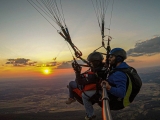Competitions in biathlon have undergone numerous regulatory changes. It is the winter sport that has evolved the most in recent years, introducing increasingly spectacular events in the World Cup and World Championships calendars.
Below, we’ll describe each of these events in detail.

Individual Race
This is the oldest biathlon competition and also the longest in terms of distance. Competitors start individually at 30-second intervals and must complete a 20-kilometre course for men and 15 kilometres for women. During the race, they perform 20 shots divided into four series—two in the prone position (first and third series) and two in the standing position (second and fourth series).
Individual Race
The firing distance to the targets is 50 metres for all competitions, with target diameters of 45 mm for the prone position (technically less challenging) and 115 mm for the standing position. The rifle weighs approximately 3.5 kilograms.
Each missed target incurs a one-minute penalty, automatically added to the biathlete’s race time. Typically, this event sees the largest time gaps between the top and bottom finishers. Note that a one-minute penalty per missed shot requires significant effort from the skier to recover lost time.
Sprint Race
Like the individual race, competitors start at 30-second intervals. Men race 10 km, while women cover 7.5 kilometres.
Each competitor must complete two shooting series (first prone, second standing). For men, the first series is around the 3 km mark and the second at 7 km. For women, shooting occurs at 2.5 km and 5 km.

In this event, each missed target requires a 150-metre penalty loop near the shooting range, taking roughly 23 seconds to complete. This is one of the most thrilling and fastest races on the calendar.
Relay Race
Each relay team consists of four biathletes, each skiing 7.5 km. Like the sprint, there are two shooting series per leg, with missed targets penalised by the same penalty loop. The team totals 30 km and 8 shooting series.
The start is a mass event; the first leg of each team begins simultaneously, and relay exchanges are made by tapping the next teammate’s back in the changeover zone (near the finish).

The key difference from individual races is that each competitor has eight bullets to hit five targets per series. After exhausting the magazine’s five rounds, remaining bullets must be loaded manually one by one, increasing time lost.
Pursuit Race
This is a new event, introduced by the IBU in the 1996-1997 World Cup and World Championships. Its standout feature is its spectacle and excitement, as the leader is always identifiable during the race.
Competitors start individually based on sprint results. In the World Cup, the top 60 sprinters start with time gaps matching their sprint finish order—the sprint winner starts first, followed by others at their respective intervals. World Championships feature the top 45 sprinters.

Men race 12.5 km, while women cover 10 kilometres.
All biathletes complete four shooting series: first two prone, last two standing. Penalties mirror the sprint (150 m loop). The IBU proposed this event for inclusion in the 2002 Salt Lake City Winter Olympics.
Mass Start
This race’s defining feature is that all competitors start simultaneously. The World Cup fields the top 27 ranked athletes, while the World Championships also includes the top three medalists from sprint and pursuit events.

Distances and shooting series resemble the pursuit, with the added rule that biathletes have eight bullets per series to hit five targets (similar to relays).
Like the pursuit, spectators always know the race leader, eliminating the wait to determine the winner.











